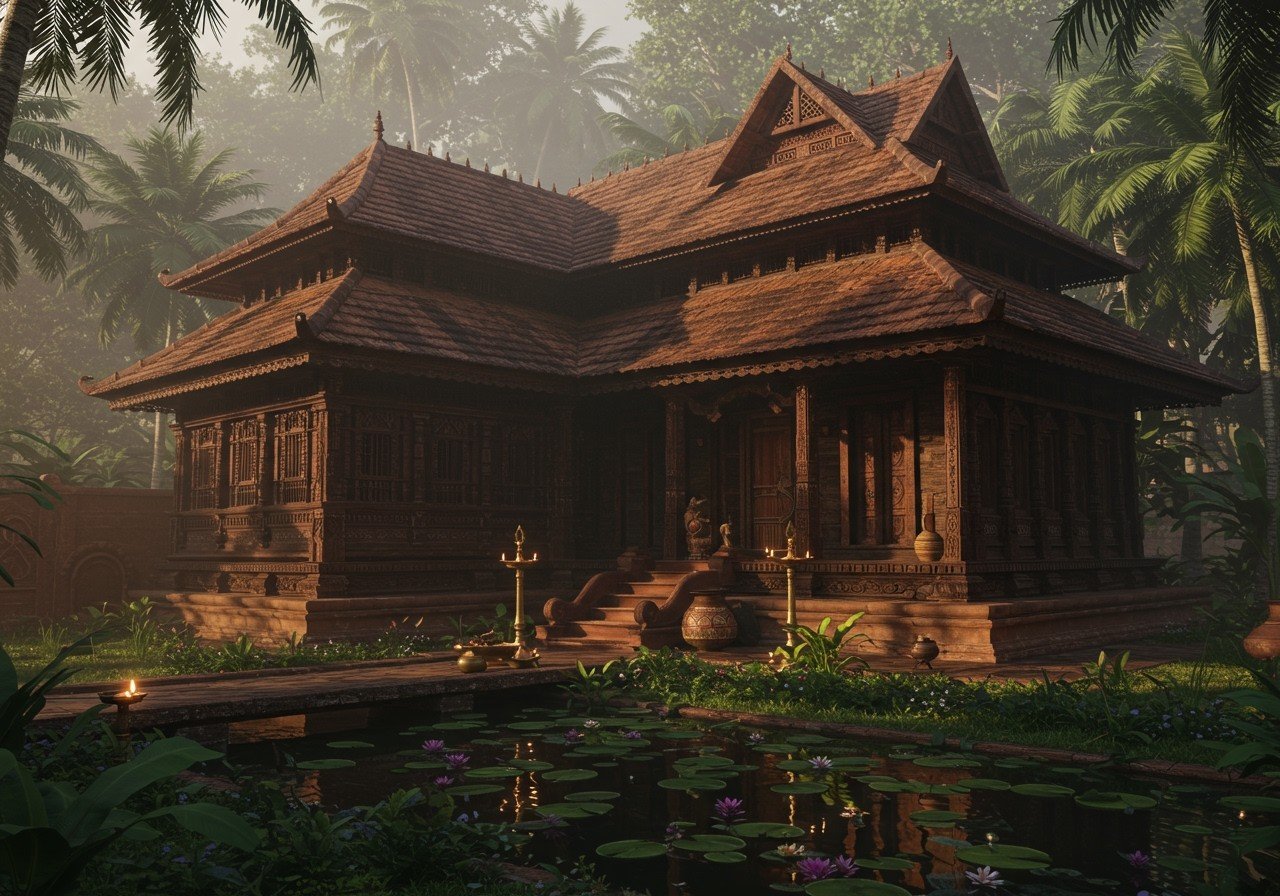
Kerala’s traditional homes are more than just buildings; they’re a reflection of the region’s rich heritage, climate, and deep-rooted cultural values. Passed down through generations, these architectural styles showcase a beautiful blend of functionality, artistry, and spiritual harmony. Let’s delve into the unique characteristics that define these timeless homes.
Key Features of Kerala Traditional Houses
Built on the principles of Vastu Shastra, Kerala’s traditional houses exhibit distinct features that make them both practical and aesthetically pleasing.
- Sloping Roofs: Kerala’s abundant rainfall necessitates roofs designed for efficient water drainage. The sloping roofs, typically made of clay tiles and sturdy timber, serve this purpose beautifully while adding to the home’s charm. These designs offer excellent thermal efficiency, keeping the interiors cool during the hot and humid months.
- Central Courtyards (Nadumuttam): The Nadumuttam, or central courtyard, is the heart of a Kerala home. This open-to-the-sky space invites natural light and ventilation, creating a comfortable living environment. It’s a place where families gather, rituals are performed, and life unfolds.
- Use of Timber: The skillful use of high-quality wood is a hallmark of Kerala architecture. Doors, windows, and pillars are often intricately carved, showcasing the artistry of local craftsmen. The warmth and elegance of wood create a welcoming ambiance.
- Natural Materials: In harmony with nature, Kerala’s traditional homes utilize locally sourced materials like stone, timber, clay, and palm leaves. This not only reduces the environmental impact but also connects the home to its surroundings, creating a sense of belonging.
- Detached Buildings: Unlike the row houses common in other parts of India, Kerala’s traditional homes often feature detached buildings. This provides privacy and allows for personalized outdoor spaces, reflecting the region’s value for individual expression within a close-knit community.
Types of Traditional Kerala Houses
Kerala’s architectural heritage boasts a variety of house styles, each with its own unique characteristics:
- Nalukettu: This traditional rectangular house features a central courtyard (Nadumuttam) surrounded by rooms on all four sides. It’s a design that fosters togetherness and is ideal for joint families, promoting a sense of community and shared living. You can explore essential items for traditional rituals performed in Nalukettu homes on poojn.in. Browse our complete collection of Kerala puja items.
- Ettukettu: Similar to the Nalukettu but grander in scale, the Ettukettu has two central courtyards. This design provides ample space for larger families and elaborate ceremonies, reflecting the region’s rich social life and traditions. Poojn.in offers a range of traditional items ideal for ceremonies conducted in Ettukettu homes. Discover our collection today.
- Pathinarukettu: The most elaborate and grand of Kerala’s traditional homes, the Pathinarukettu features sixteen blocks arranged around two central courtyards. Historically reserved for the wealthiest families and local rulers, it stands as a testament to architectural brilliance and social standing. Find exquisite pieces for your Pathinarukettu rituals here..
- Kerala Vernacular Architecture Homes: Reflecting a deep respect for nature, these eco-friendly homes are built with locally sourced materials like bamboo, mud, and thatch. They represent a sustainable approach to living, honoring the wisdom of traditional building practices.
FAQs: Understanding Kerala’s Traditional Architecture
What distinguishes traditional Kerala architecture? Traditional Kerala architecture stands apart with its sloping roofs, natural materials, and the central courtyard, all designed in harmony with the local climate and cultural practices.
Could you explain the significance of Nalukettu? Nalukettu, meaning “four blocks,” is a traditional house style centered around a courtyard, promoting ventilation and family interaction.
Why are courtyards so important in these homes? Courtyards are integral to Kerala architecture, bringing in light, air, and a sense of connection to nature, fostering a peaceful and harmonious living environment.
Preserving a Legacy
Kerala’s traditional houses are not just structures; they are living embodiments of a rich cultural narrative. By understanding and appreciating these architectural gems, we celebrate the ingenuity and artistry of generations past. As we embrace modern living, let’s strive to preserve the essence of these traditions, ensuring that the legacy of Kerala architecture continues to inspire and enrich our lives.


